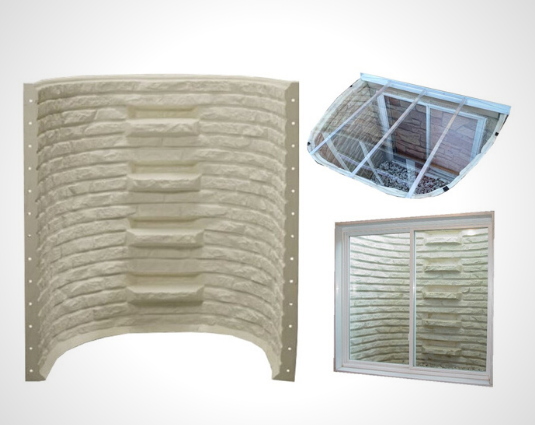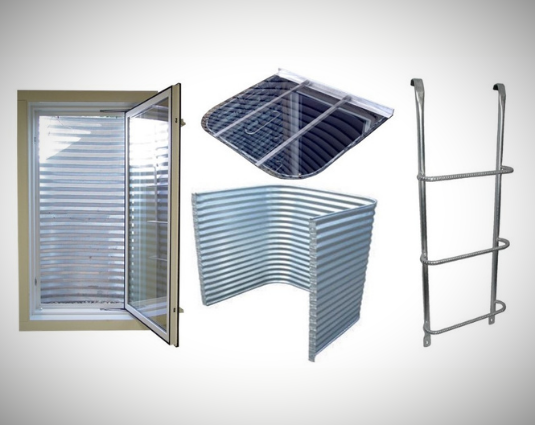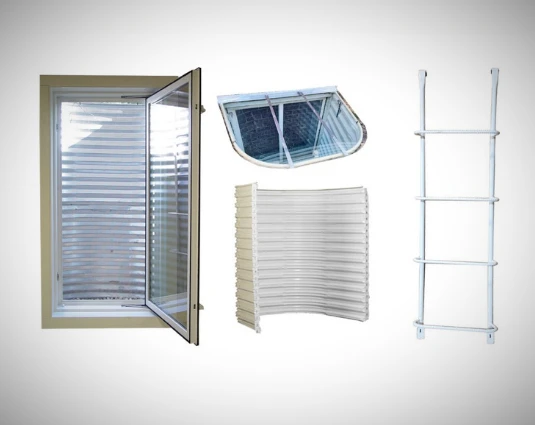Utah Egress Codes
UTAH IRC ADOPTION
IRC VERSION
2015
ADOPTION
X
X – Effective Statewide
RESOURCES
Uniform Building Codes website: https://dopl.utah.gov/ubc/index.html
Contact list: https://dopl.utah.gov/ubc/associations.pdf
IRC EGRESS CODES - QUICK GLANCE
Window Well Requirements For Egress
Minimum Width
36"
Minimum Projection
36"
Maximum Depth
44"
Without an Egress Ladder
Maximum Depth
∞
With a Permanent Egress Ladder
Basement Window Requirements For Egress
Minimum Opening
5.7 ft²
Above Grade
Minimum Opening
5 ft²
Below Grade
Minimum Width
20"
Minimum Height
24"
The State Construction and Fire Codes Act (Title 15A) governs how building codes are adopted in Utah. For each update of a “nationally recognized construction code” The Uniform Building Code Commission has two years to prepare a report for the Utah State Legislature stating recommending updates and modifications and compiles costs and benefits for each recommended change.
For the IRC and residential portions of the IECC, this process occurs every other cycle. Political subdivisions may not enforce a rule or requirements that are more restrictive than the state construction code. Membership to The Uniform Building Code Commission and Utah State Fire Prevention Board are approved by the State Legislature.
- 2015 International Residential Code
For the past several years, Utah State Statute 58-56-4 required statewide adoption of a building code, residential code, plumbing code, mechanical code, and fuel gas code promulgated by a nationally recognized code authority. The 2009 passage of SB211 moved the adoption authority to the state legislature. The Uniform Building Code Commission is now required to make adoption recommendations to the interim Senate Business and Labor Committee.
A law was passed in 2016 that restricted the IRC to a six year adoption cycle.
Last updated: Tue, Mar 14, 2023
Notice: It’s important to verify with your local county building inspector not only the state construction code but also Utah egress window requirements before starting a project. We try to keep this database up-to-date as best as possible, but express no warranties on accuracy of information. If you find a mistake or have any questions, please call 1-888-650-9355
2015 INTERNATIONAL RESIDENTIAL CODES – SECTION R310
EMERGENCY ESCAPE AND RESCUE OPENINGS
R310.1 Emergency escape and rescue opening required.
Basements, habitable attics and every sleeping room shall have not less than one operable emergency escape and rescue opening. Where basements contain one or more sleeping rooms, an emergency escape and rescue opening shall be required in each sleeping room. Emergency escape and rescue openings shall open directly into a public way, or to a yard or court that opens to a public way.
Exception: Storm shelters and basements used only to house mechanical equipment not exceeding a total floor area of 200 square feet (18.58 m2).
- Because so many fire deaths occur as a result of occupants being asleep in a residential building during a fire, the code requires that all basements, habitable attics and sleeping rooms have windows or doors that may be used for emergency escape or rescue. The requirement for emergency escape and rescue openings in sleeping rooms exists because a fire will usually have spread before the occupants are aware of the problem, and the normal exit channels may be blocked. The requirement for basements and habitable attics exists because they are so often used as sleeping rooms. A fire in a mechanical room adjacent to a stairway could engulf the only means of egress for the basement without the egress window or door.
Openings required for emergency escape or rescue must be located on the exterior of the building so that rescue can be performed from the exterior and so that occupants may escape through that opening to the exterior of the building without having to travel through the building itself. Therefore, where openings are required, they should open directly into a public street, public alley, yard or court. After the occupants pass through the emergency escape and rescue opening, their continued egress is essential. Where a basement contains sleeping rooms and a habitable space, an emergency escape and rescue opening is required in each sleeping room, but is not required in adjoining areas of the basement.
There is an exception for storm shelters and basements used only to house mechanical equipment with a total floor area not exceeding 200 square feet (18.58 m2).
The dimensions prescribed in the code for emergency escape and rescue openings in Sections R310.2 through R310.2.2, and as illustrated in Commentary Figure R310.2.1, are based, in part, on extensive testing by the San Diego Building and Fire Departments to determine the proper relationships of the height and width of window openings to adequately serve for both rescue and escape. The minimum of 20 inches (508 mm) for the width is based on two criteria: the width necessary to place a ladder within the window opening and the width necessary to admit a fire fighter with full rescue equipment, including a breathing apparatus. The minimum 24-inch (610 mm) height is based on the minimum size necessary to admit a fire fighter with full rescue equipment. By requiring a minimum net clear opening size of at least 5.7 square feet (0.53 m2), the code provides for an opening of adequate dimensions. To be accessible from the interior of the sleeping room, attic or basement, Section R310.2.2 requires that the emergency escape and rescue opening be located not more than 44 inches (1118 mm) above the floor. The measurement is to be taken from the floor to the bottom of the clear opening.
Section R310.1.1 requires that the required opening dimensions be achieved by the normal operation of the window, door or hatch from the inside without the use of keys, tools or special knowledge. Section R310.1.1 also allows window opening control devices to be used on windows that serve as required emergency escape and rescue openings, provided that such devices comply with ASTM F2090. The window industry is a highly competitive market. Manufacturers are constantly developing new products that are easier to clean and possess higher thermal protection properties. It is important to keep in mind that no special knowledge for operation of the egress window is a key operational constraint. It is impractical to assume that all occupants can operate a window that requires a special sequence of operations to achieve the required opening size. Although most occupants are familiar with the normal operation to open the window, children and guests are frequently unfamiliar with special procedures necessary to remove the sashes. The time spent comprehending special operations unnecessarily delays egress from the bedroom and could lead to panic and further confusion. Thus, windows that achieve the required opening dimensions only by performing a special sequence of operations, such as the removal of sashes or mullions, are not permitted. For example, if a specific area of the window has to be depressed or manipulated to allow the sash to be removed or released to achieve the open area requirement of 5.7 square feet (0.53 m2), the window does not qualify as an egress window.
R310.1.1 Operational constraints and opening control devices.
Emergency escape and rescue openings shall be operational from the inside of the room without the use of keys, tools or special knowledge. Window opening control devices complying with ASTM F2090 shall be permitted for use on windows serving as a required emergency escape and rescue opening.
- Openings for emergency escape and rescue must be operational from the inside. Keys, tools or special knowledge must not be needed to operate these openings. If keys or tools were necessary, they might not be readily available in an emergency or panic situation, and an individual might not be able to operate them, rendering the opening unusable. Section R310.1 also requires the opening size to be obtained by the normal operation of the window (see commentary to Section R310.1).
R310.2 Emergency escape and rescue openings.
Emergency escape and rescue openings shall have minimum dimensions as specified in this section.
- See the commentary to Section R310.1.
R310.2.1 Minimum opening area.
Emergency and escape rescue openings shall have a net clear opening of not less than 5.7 square feet (0.530 m2). The net clear opening dimensions required by this section shall be obtained by the normal operation of the emergency escape and rescue opening from the inside. The net clear height opening shall be not less than 24 inches (610 mm) and the net clear width shall be not less than 20 inches (508 mm).
Exception: Grade floor or below grade openings shall have a net clear opening of not less than 5 square feet (0.465 m2).
- The minimum opening dimensions for emergency space and rescue openings are 24 inches (610 mm) in height and 20 inches (508 mm) in width. These dimensions are based on the minimum dimensions for a fire fighter with full rescue equipment to navigate through the opening (see commentary to Section R310.1 and Commentary Figure R310.2.1). Note that this section requires a minimum opening area of 5.7 square feet, which cannot be achieved if both the minimum height and the minimum width dimensions are used.
The exception allows the opening size requirement to be reduced to 5 square feet (0.46 m2) where the emergency escape and rescue window is located at grade level. This results from the increased ease of access from the exterior and the probability that a ladder will not be needed (see Commentary Figure R310.2.1).
R310.2.2 Window sill height.
Where a window is provided as the emergency escape and rescue opening, it shall have a sill height of not more than 44 inches (1118 mm) above the floor; where the sill height is below grade, it shall be provided with a window well in accordance with Section R310.2.3.
- See the commentary to Section R310.1.
Figure R310.2.3 WINDOW WELLS
R310.2.3 Window wells.
The horizontal area of the window well shall be not less than 9 square feet (0.9 m2), with a horizontal projection and width of not less than 36 inches (914 mm). The area of the window well shall allow the emergency escape and rescue opening to be fully opened.
Exception: The ladder or steps required by Section R310.2.3.1 shall be permitted to encroach not more than 6 inches (152 mm) into the required dimensions of the window well.
- Window wells in front of emergency escape and rescue openings also have minimum size requirements. These provisions address those emergency escape windows that occur below grade. Just applying the standard emergency escape window criteria to these windows will result in an opening that occupants can get through, but the window well may actually trap the occupants against the building without providing for their escape from the window well or providing for a firefighter to enter the residence.
The minimum size requirements in cross-section are similar to the emergency escape and opening criteria; that is, they are sufficient to provide a nominal size to allow for the escape of occupants or the entry of firefighters (see Commentary Figure R310.2.3). The ladder or steps required is the main difference.
For SI: 1 inch = 25.4 mm, 1 square foot = 0.0929 m2.
Figure R310.2.3WINDOW WELLS
R310.2.3.1 Ladder and steps.
Window wells with a vertical depth greater than 44 inches (1118 mm) shall be equipped with a permanently affixed ladder or steps usable with the window in the fully open position. Ladders or steps required by this section shall not be required to comply with Sections R311.7 and R311.8. Ladders or rungs shall have an inside width of not less than 12 inches (305 mm), shall project not less than 3 inches (76 mm) from the wall, and shall be spaced not more than 18 inches (457 mm) on center vertically for the full height of the window well.
- When the depth of a window well exceeds 44 inches (1118 mm), a ladder or steps from the window is required. The details for construction of steps are not identified in the provisions; however, the design of the ladder is specifically addressed. Because ladders and steps in window wells are provided for emergency use only, they are not required to comply with the provisions for stairways found in Section R311.7.
R310.2.3.2 Drainage.
Window wells shall be designed for proper drainage by connecting to the building’s foundation drainage system required by Section R405.1 or by an approved alternative method.
Exception: A drainage system for window wells is not required where the foundation is on well-drained soil or sand-gravel mixture soils in accordance with the United Soil Classification System, Group I Soils, as detailed in Table R405.1.
- This section requires the window well to be properly drained. Improper window well drainage could create a water accumulation level that could cause the window to become inoperable, or even break due to the pressure and blow out into the occupied room causing serious injury. Improper window well drainage may cause an emergency escape window to become a hazard to the occupants. If the foundation is on well-drained soil, the exception permits deletion of the drainage system.
R310.2.4 Emergency escape and rescue openings under decks and porches.
Emergency escape and rescue openings shall be permitted to be installed under decks and porches provided that the location of the deck allows the emergency escape and rescue openings to be fully opened and provides a path not less than 36 inches (914 mm) in height to a yard or court.
- The design of some homes makes the underside of decks the only location where an emergency escape and rescue window can be located. The 36-inch (914 mm) minimum height requirement allows a usable means of egress pathway. The 36-inch (914 mm) minimum height was based on the minimum window well size of 3 feet by 3 feet (914 mm by 914 mm).
R310.2.5 Replacement windows.
Replacement windows installed in buildings meeting the scope of this code shall be exempt form the maximum sill height requirements of Sections R310.1 and Sections R310.2.1 and R310.2.2, provided the replacement window meets the following conditions:
The replacement window is the manufacturer’s largest standard size window that will fit within the existing frame or existing rough opening. The replacement window is of the same operating style as the existing window or a style that provides for an equal or greater window opening area than the existing window.
The replacement window is not part of a change of occupancy.
- Window replacements are one of the most common alterations to existing one- and two-family dwellings and townhomes. These provisions are based on requirements in the State of Minnesota’s residential code and are consistent with similar provisions in the International Existing Building Code®(IEBC®).
Requiring replacement windows to meet the strict requirements for emergency escape and rescue openings, such as is required by Sections R310.2.1 and R310.2.2 for basements, habitable attics and sleeping rooms in new buildings, can be prohibitive and can discourage alterations that might otherwise improve building safety. These requirements are intended to ensure that the IRC does not discourage or prevent improvements in emergency escape and rescue openings, especially improvements related to fire safety, in older residential occupancies.
Many older dwellings have been constructed under codes that did not include the same emergency escape and rescue opening provisions that the IRC now requires for new construction. As such, window replacements often could only be accomplished by increasing the size of the rough opening, altering the interior and/or exterior walls and/or lowering the window sill height. This often led to significant costs and design challenges. This could discourage or prevent window replacement and, at worst, could discourage or prevent the replacement of older windows that may be (a) harder to operate, (b) inoperable due to their age or to poor maintenance, or (c) significantly less energy efficient. When that happens, improvements to safety as well as energy efficiency may be needlessly compromised. For these reasons, the provisions of this section relax the opening size and sill height requirements for replacement windows in existing buildings, as compared to the emergency escape and rescue opening requirements for new construction contained in Sections R310.2.1 and R310.2.2. For example, while some windows in sleeping rooms of older homes may not provide the full clear opening that is required for new construction or may have a sill height above 44 inches, they nonetheless may still provide a viable emergency and escape rescue opening, which is the primary intent of the code. Replacement of these windows with the same type of operating window or other type that can provide an equal or greater clear opening than the existing window—even if they do not fully meet the clear opening or sill height requirements of Section 310—is always an improvement in safety, especially when a replacement opening can provide a larger clear opening than the existing window. Such improvements in safety should not be discouraged or prevented by overly onerous requirements for replacement windows.
These requirements ensure that does not happen by essentially providing limited exceptions to the requirements of Section 310 that can only be applied when certain conditions are met and an acceptable level of safety is provided. The requirements for new construction stating that emergency escape and rescue openings be provided as well as the operational requirements of Section 310.1.1 are retained and are still applicable to replacement windows.
Browse egress codes by state
- Alabama
- Alaska
- Arizona
- Arkansas
- California
- Colorado
- Connecticut
- Delaware
- Florida
- Georgia
- Hawaii
- Idaho
- Illinois
- Indiana
- Iowa
- Kansas
- Kentucky
- Louisiana
- Maine
- Maryland
- Massachusetts
- Michigan
- Minnesota
- Mississippi
- Missouri
- Montana
- Nebraska
- Nevada
- New Hampshire
- New Jersey
- New Mexico
- New York
- North Carolina
- North Dakota
- Ohio
- Oklahoma
- Oregon
- Pennsylvania
- Rhode Island
- South Carolina
- South Dakota
- Tennessee
- Texas
- Utah
- Vermont
- Virginia
- Washington
- Washington D.C.
- West Virginia
- Wisconsin
- Wyoming
Find your state’s IRC code adoption
Download the State Local Codes Chart PDF to determine which International Residential Code your state follows. Depending on your State, your local county may have additional/different requirements. Please refer to your local government website for up-to-date information and to confirm the information on this page.
Copyright 2024 WindowWellExperts.com, All Rights Reserved




